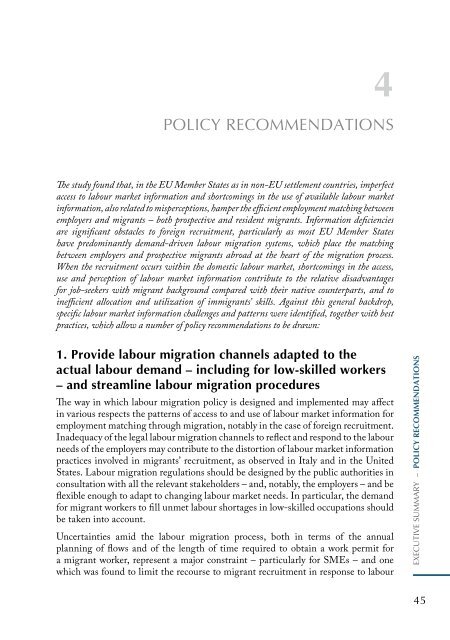International Organization for Migration (IOM)
International Organization for Migration (IOM)
International Organization for Migration (IOM)
You also want an ePaper? Increase the reach of your titles
YUMPU automatically turns print PDFs into web optimized ePapers that Google loves.
4<br />
4poLIcy recommendAtIons<br />
The study found that, in the EU Member States as in non-EU settlement countries, imperfect<br />
access to labour market in<strong>for</strong>mation and shortcomings in the use of available labour market<br />
in<strong>for</strong>mation, also related to misperceptions, hamper the efficient employment matching between<br />
employers and migrants – both prospective and resident migrants. In<strong>for</strong>mation deficiencies<br />
are significant obstacles to <strong>for</strong>eign recruitment, particularly as most EU Member States<br />
have predominantly demand-driven labour migration systems, which place the matching<br />
between employers and prospective migrants abroad at the heart of the migration process.<br />
When the recruitment occurs within the domestic labour market, shortcomings in the access,<br />
use and perception of labour market in<strong>for</strong>mation contribute to the relative disadvantages<br />
<strong>for</strong> job-seekers with migrant background compared with their native counterparts, and to<br />
inefficient allocation and utilization of immigrants’ skills. Against this general backdrop,<br />
specific labour market in<strong>for</strong>mation challenges and patterns were identified, together with best<br />
practices, which allow a number of policy recommendations to be drawn:<br />
1. Provide labour migration channels adapted to the<br />
actual labour demand – including <strong>for</strong> low-skilled workers<br />
– and streamline labour migration procedures<br />
The way in which labour migration policy is designed and implemented may affect<br />
in various respects the patterns of access to and use of labour market in<strong>for</strong>mation <strong>for</strong><br />
employment matching through migration, notably in the case of <strong>for</strong>eign recruitment.<br />
Inadequacy of the legal labour migration channels to reflect and respond to the labour<br />
needs of the employers may contribute to the distortion of labour market in<strong>for</strong>mation<br />
practices involved in migrants’ recruitment, as observed in Italy and in the United<br />
States. Labour migration regulations should be designed by the public authorities in<br />
consultation with all the relevant stakeholders – and, notably, the employers – and be<br />
flexible enough to adapt to changing labour market needs. In particular, the demand<br />
<strong>for</strong> migrant workers to fill unmet labour shortages in low-skilled occupations should<br />
be taken into account.<br />
Uncertainties amid the labour migration process, both in terms of the annual<br />
planning of flows and of the length of time required to obtain a work permit <strong>for</strong><br />
a migrant worker, represent a major constraint – particularly <strong>for</strong> SMEs – and one<br />
which was found to limit the recourse to migrant recruitment in response to labour<br />
eXecutIve summAry – POLICY RECOMMENDATIONS<br />
45


